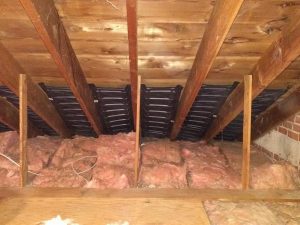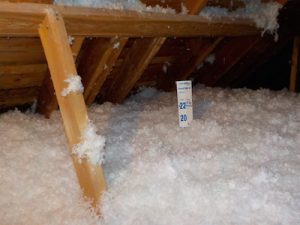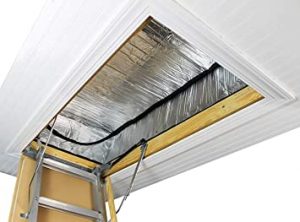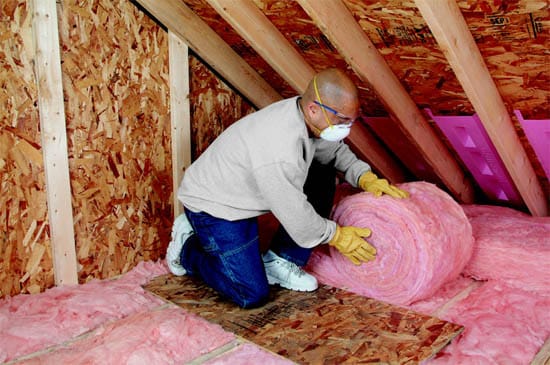Sealing
Attics are a place where warm air will leak out of the home in the winter and into the home in the summer. Trouble spots for air leakage include any area which comes through the attic floor, including but not limited to, recessed can lights, chimneys & flues, pipes, wires, ducts, and the attic door itself. These areas should be sealed before adding insulation, because the insulation will block access to these areas. Necessary supplies include caulk, expanding foam & weather stripping to seal any leaks into your attic.
Ventilation
Many attics are under-ventilated, which allows moisture and heat to build up in the attic. Excessive amounts of moisture  can cause wood rot and mold growth. During the summer, an under-ventilated attic is likely to overheat, which can bake the shingles on your roof, reducing their life expectancy. Although not as common in the south, in the winter, an attic which is under-ventilated can warm up, which could melt snow on the roof, which then drains into the gutters and freezes again, causing ice dams. Proper attic ventilation lets air flow in from a low point, and allows it to exhaust from a high point. In most modern homes, this is accomplished with soffit vents (the perforated sections under your eaves) & baffles (the styrofoam or cardboard pieces between truss cavities in your attic) coupled with ridge vents (at the top of your peak). Some homes may have electric, mechanical, or solar ventilators, or fans, installed to assist in removing the hot air.
can cause wood rot and mold growth. During the summer, an under-ventilated attic is likely to overheat, which can bake the shingles on your roof, reducing their life expectancy. Although not as common in the south, in the winter, an attic which is under-ventilated can warm up, which could melt snow on the roof, which then drains into the gutters and freezes again, causing ice dams. Proper attic ventilation lets air flow in from a low point, and allows it to exhaust from a high point. In most modern homes, this is accomplished with soffit vents (the perforated sections under your eaves) & baffles (the styrofoam or cardboard pieces between truss cavities in your attic) coupled with ridge vents (at the top of your peak). Some homes may have electric, mechanical, or solar ventilators, or fans, installed to assist in removing the hot air.
There are three primary types of insulation used in attics, loose-fill, batt, and rigid. However, we generally only see loose-fill and batt in central North Carolina. Whatever type of insulation you have, it should provide a high enough level of insulation (measured in R-value) for where you live. The higher the R-value, the better the insulation will be at retaining heat. In North Carolina, current code requires a minimum of R-38, however the US Dept. of Energy recommends the R value be anywhere from 30 to 60 (US Dept. Of Energy Insulation Information).
 Batt and rigid insulation will usually have the R-value written on the product. However, loose-fill insulation, sometimes called blown insulation because it is blown in to the attic, requires the R-value be calculated by the depth of the insulation (hence the paper rulers you may have seen in your attic). The formula is the depth in inches multiplied by 2.8. In NC, most homes should have a minimum of 14″ of blown insulation. To have the maximum recommended insulation rating of R-60, you would need 21.5″ of loose-fill insulation. If your home has loose-fill insulation which is less than the recommended amount, or you want to add more, you can simply add more on top of it, as long as there aren’t any moisture or rodent issues. If your home was built prior to 1990, and the loose-fill is original to the house, there is a possibility it could be vermiculite, which may have Asbestos. Asbestos can cause cancer when the particles are released into the air, so I would suggest you have it tested before making changes in your attic. If it is contaminated with asbestos, you should have it removed by a professional before doing any work in your attic, OR leave it alone. Asbestos is perfectly safe if it is not disturbed.
Batt and rigid insulation will usually have the R-value written on the product. However, loose-fill insulation, sometimes called blown insulation because it is blown in to the attic, requires the R-value be calculated by the depth of the insulation (hence the paper rulers you may have seen in your attic). The formula is the depth in inches multiplied by 2.8. In NC, most homes should have a minimum of 14″ of blown insulation. To have the maximum recommended insulation rating of R-60, you would need 21.5″ of loose-fill insulation. If your home has loose-fill insulation which is less than the recommended amount, or you want to add more, you can simply add more on top of it, as long as there aren’t any moisture or rodent issues. If your home was built prior to 1990, and the loose-fill is original to the house, there is a possibility it could be vermiculite, which may have Asbestos. Asbestos can cause cancer when the particles are released into the air, so I would suggest you have it tested before making changes in your attic. If it is contaminated with asbestos, you should have it removed by a professional before doing any work in your attic, OR leave it alone. Asbestos is perfectly safe if it is not disturbed.
Another insulation tip is to install an attic stair tent. If you have a scuttle hole or pull down stairs, this opening can be a  huge source of air leakage and heat loss. An attic tent is a reflective, zippered enclosure that sits above the stairs or scuttle of your attic access. It works by providing a little bit of insulation value to the opening, and prevents air leakage through the opening. They are fairly easy to install (most install with screw or staples and some expanding foam for the cracks) and can make a huge difference if the area immediately under your access often feels warmer in the summer.
huge source of air leakage and heat loss. An attic tent is a reflective, zippered enclosure that sits above the stairs or scuttle of your attic access. It works by providing a little bit of insulation value to the opening, and prevents air leakage through the opening. They are fairly easy to install (most install with screw or staples and some expanding foam for the cracks) and can make a huge difference if the area immediately under your access often feels warmer in the summer.
Insulation Installation

If you’re a DIY pro and decide to do this work yourself, you can rent an insulation blowing machine from Lowes or Home Depot, when you buy the bags of loose-fill insulation. They have a calculator in the store with the machines to figure out how much to buy based on the square footage of the attic and the desired depth of insulation. Doing it yourself is NOT a one person job, you’ll need at least one person to hold the hose and apply the insulation in the attic, and another person outside feeding the blowing machine. It is hot, dusty work, so protect yourself appropriately with long pants, long sleeve apparel, masks, gloves, and eye protection.  Other hazards can include loose electrical wires, roofing nails that pierce the attic ceiling (ouch!), and most important, accidentally stepping off the rafters. Your sheetrock ceiling will NOT support your weight, and if you step off your wood rafters you can fall through the ceiling, causing an injury to you and making a huge mess. If this seems daunting to you, there are lots of people in the area you can hire which can successfully complete this task. I’d be happy to recommend somebody, or you can google local insulation companies.
Other hazards can include loose electrical wires, roofing nails that pierce the attic ceiling (ouch!), and most important, accidentally stepping off the rafters. Your sheetrock ceiling will NOT support your weight, and if you step off your wood rafters you can fall through the ceiling, causing an injury to you and making a huge mess. If this seems daunting to you, there are lots of people in the area you can hire which can successfully complete this task. I’d be happy to recommend somebody, or you can google local insulation companies.
I hope these tips will help you take the next steps to a more energy-efficient home! Central Carolina Home Inspections, LLC offers home inspection services to Central North Carolina. Contact us to request an appointment.


Recent Comments